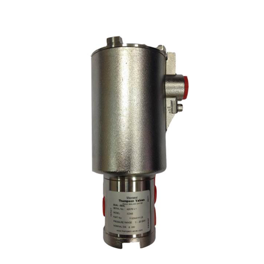

A solenoid valve is an electrically controlled valve used for the automatic control of fluid flow. The solenoid part of a solenoid valve is actually an electric coil that has a movable ferromagnetic core or plunger at its centre. In the closed position, this plunger shuts off a small orifice.
When an electric current is passed through the coil a magnetic field is created, which forces the plunger upwards. Thus, opening the orifice. When the coil is de-energised, the plunger returns to the closed position one more by the action of a spring.
There are various different types of solenoid valves, depending on the application. Read on to find out what a solenoid valve does, how the various different types of solenoid valves function, their typical applications, and their specific benefits.
Solenoid valves are typically categorised according to the mode of actuation and the number of ports. The following are amongst the most popular types of solenoid valves.
Direct-acting solenoid valves feature a seat seal that is attached to the solenoid core. When the valve is energised, the seat orifice opens and when de-energised it closes. Within this family of solenoid valves you will find 2-way and 3-way valves. Two-way valves are shut-off valves with one inlet port and one outlet port, while a three-way valve has three port connections and two valve seats.
A 2-way direct-acting solenoid valve relies on a combination of the core spring and fluid pressure to keep the valve seat closed. Once energised, the valve opens as the core and seal are pulled into the solenoid coil. With a 3-way direct-acting solenoid valve, one seal is always open while the other is closed and this is reversed when the solenoid coil becomes energised. These types of valves are typically used with smaller flow rates.
Direct-acting solenoid valves offer a number of advantages. Not only are they suitable for negative pressure circuits and can cope with particle debris, but they also come in highly cost-effective and compact sizes. Direct-acting 2-way plunger valves are used in a wide range of applications, including the shut-off, dosing, filling and ventilation of neutral and clean liquids, gases and vapours.
For larger flow rates, internally piloted solenoid valves offer the ideal solution. These types of solenoid valves are used for switching higher pressures within larger pipe sizes, with the differential fluid pressure doing most of the heavy lifting in terms of opening and closing the valve. Pilot solenoid valves offer other benefits too, including the ability to be operated at higher pressures and temperatures, and low power consumption.
A diaphragm solenoid valve with pilot control features a small chamber above the diaphragm. The process fluid enters this chamber through a small orifice in the inlet port. The fluid compresses the diaphragm and forces it against the seat to maintain a closing seal (normally closed). When the pilot solenoid valve is energised, the diaphragm is pulled upwards and the fluid in the chamber is back out into the main flow through the valve.
Internally piloted solenoid valves offer a number of benefits. Not only are they more efficient and economical for higher flow values, they also require minimal pressure differential. They also require lower electrical power. Pilot-operated valves are typically used with liquid or gaseous media (like water or compressed air) in closed circuits that have little or no differential pressure for opening and closing the valve.
Fluid Controls offers an extensive selection of solenoid valves from the most respected manufacturers in the industry. Our Parker Lucifer range includes 2-way solenoid valves for direct-acting and pilot operated valves, as well as 3-way and 4-way direct-acting models. Our Maxseal range of stainless steel solenoids includes the 3/2-way ICO3S and 2/2, 3/2 or 5/2-way ICO4S direct acting poppet valves – both of which are ATEX-approved.
For more information about our solenoid valve products, or to discuss your application requirements in more detail, please contact Fluid Controls today on +44 (0)118 970 2060 or email fluid@fluidcontrols.co.uk.
If you enjoyed this article, why not find out more about the benefits of solenoid valves?